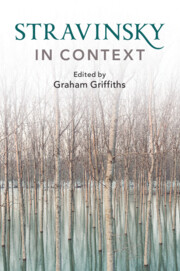Book contents
- Stravinsky in Context
- Composers in Context
- Stravinsky in Context
- Copyright page
- Contents
- Illustrations
- Contributors
- Preface
- Abbreviations
- Frontispiece
- Epigraph
- Part I Russia and Identity
- Part II Stravinsky and Europe
- Chapter 7 Sergei Diaghilev and Stravinsky: From World of Art to Ballets Russes
- Chapter 8 Paris and the Belle Époque
- Chapter 9 Paris, Art Deco and the Spirit of Apollo
- Chapter 10 Stravinsky’s Spain: Fan or Mirror?
- Chapter 11 ‘It is Venice that he loves’
- Part III Partnerships and Authorship
- Part IV Performance and Performers
- Part V Aesthetics and Politics
- Part VI Reception and Legacy
- Recommendations for Further Reading and Research
- Index
- Endmatter
Chapter 11 - ‘It is Venice that he loves’
from Part II - Stravinsky and Europe
Published online by Cambridge University Press: 03 December 2020
- Stravinsky in Context
- Composers in Context
- Stravinsky in Context
- Copyright page
- Contents
- Illustrations
- Contributors
- Preface
- Abbreviations
- Frontispiece
- Epigraph
- Part I Russia and Identity
- Part II Stravinsky and Europe
- Chapter 7 Sergei Diaghilev and Stravinsky: From World of Art to Ballets Russes
- Chapter 8 Paris and the Belle Époque
- Chapter 9 Paris, Art Deco and the Spirit of Apollo
- Chapter 10 Stravinsky’s Spain: Fan or Mirror?
- Chapter 11 ‘It is Venice that he loves’
- Part III Partnerships and Authorship
- Part IV Performance and Performers
- Part V Aesthetics and Politics
- Part VI Reception and Legacy
- Recommendations for Further Reading and Research
- Index
- Endmatter
Summary
Why Igor Stravinsky should wish to be buried in the Venetian island cemetery of San Michele is an intriguing question for he was less moved by historical precedent, it seems, than one might suppose (Fig. 11.1). Sergei Diaghilev, of course, who had done so much to foster Stravinsky’s early career, died in Venice (on 29 August 1929) and was buried there. Wagner, too, had died in Venice (on 13 February 1883 at the palace of Ca’ Vendramin Calergi), his body conveyed by funerary gondola along the Grand Canal before being transported back to Germany for burial in Bayreuth, in the gardens of Villa Wahnfried. When Stravinsky was still an infant, public recollection of these events would have been rekindled by Liszt’s prophetic piano solo La Lugubre Gondola, composed just before Wagner’s death. Far older still is the timeless theme of Death crossing the waters. Its mythical pedigree derives from the earliest portraits of Charon ferrying souls over the River Acheron, to Arnold Böcklin’s mysterious Isle of the Dead (1880), a painting that was so popular in the early twentieth century and the source of not a few symphonic poems, for example by Rachmaninov (1909) and Max Reger (1913). With Thomas Mann’s novella Der Tod in Venedig (1912) death in Venice also became a literary topic, yet it seems that for Stravinsky it was more a question of aesthetic preference: Venice was the city that he loved the most. His association with the city was particularly close.
Keywords
- Type
- Chapter
- Information
- Stravinsky in Context , pp. 98 - 106Publisher: Cambridge University PressPrint publication year: 2020

